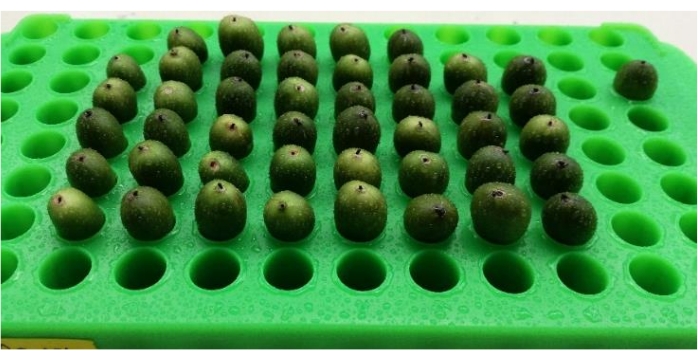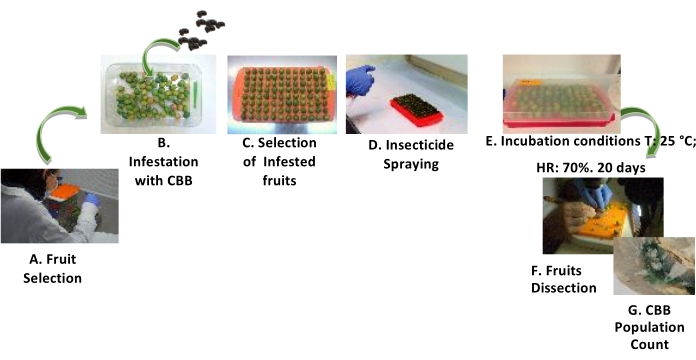需要订阅 JoVE 才能查看此. 登录或开始免费试用。
Method Article
针对咖啡浆果螟子下皮测试控制剂和杀虫剂 的方法
摘要
开发了一种使用生咖啡果实(GF)来测试杀虫剂对咖啡浆果螟(CBB)的毒性的方法。在CBB感染之前或之后,对消毒的GF施用杀虫剂或有毒物质。除了其他参数外,还评估了昆虫死亡率,排斥性和繁殖能力。
摘要
在推荐杀虫剂治疗咖啡浆果螟(CBB) 下颌骨之前,了解这些杀虫剂对成年昆虫的死亡率和排斥性或其对生殖输出的影响是有价值的。然而,目前可用的方法仅评估成人死亡率,限制了具有不同作用模式的新型杀虫剂的选择。在这项工作中,检查了不同的实验方法,以确定实验室条件下对CBB的不同影响。为此,收集生咖啡果实(GF)并通过浸入次氯酸钠溶液中然后用紫外线照射进行消毒。同时,来自菌落的CBB成虫通过浸入次氯酸钠溶液中进行消毒。为了评估水果保护(预感染),将水果放在塑料盒中,并施用杀虫剂。然后,CBB成虫以每个GF两个CBB的速度释放。将GF置于受控条件下,以评估CBB感染和1,7,15和21天后的存活率。为了评估CBB感染后(感染后)的杀虫剂功效,将CBB成虫在21°C下以2:1的比例释放到GF中3小时。 选择显示腹部部分暴露的CBB成虫的受感染水果并将其放置在96孔架中,并直接处理钻入水果中的CBB。20天后,对果实进行解剖,并记录每个果实内的CBB生物阶段。GF用作模拟自然条件的基质,以评估针对CBB的有毒,化学和生物杀虫剂。
引言
咖啡浆果螟(CBB), 即汉贝亚螟,于1988年在哥伦比亚首次被发现,此后成为咖啡作物中最重要的害虫种类。CBB雌性离开已经受精的出生果实,在它们排放的挥发性化学物质的指导下寻找新的果实1,2。在25°C的温度下,在23天3 内完成一个完整的循环。 这个循环从创始人雌性穿透种子并在果实胚乳中产卵开始。蜕皮的幼虫吃掉种子。如果此时解剖果实,就有可能同时观察创始雌性和她的后代。14天后,幼虫变成蛹 - 一般来说,蛹期持续5天。在成年期,雌性与兄弟姐妹交配,新受精的雌性从受损的水果中飞走,寻找新的咖啡果实,开始新的周期4。
渗透过程和幼虫喂养的结果都会损害咖啡种子,降低咖啡饮料的质量并显着降低收入;咖啡种植园中超过5%的感染通常被认为是经济阈值。
CBB控制基于病虫害综合治理(IPM)策略,包括文化控制和农艺实践,天然生物制剂以及化学杀虫剂的使用,这需要安全条件和及时应用4.
为了评估用于控制CBB的新杀虫剂,需要低成本的方法,以便能够快速获得结果。目前正在使用实验室和现场程序,包括含有含有杀虫剂的咖啡的人工日粮5,6,或将杀虫剂喷洒在干羊皮纸咖啡7,8,9上。此外,据报道,使用覆盖有昆虫学套筒的咖啡树枝在野外进行的实验有10,11;然而,这些方法需要高强度的劳动和漫长的评估周期。
一种类似于自然场条件的条件,也是快速和廉价的,是使用绿色或成熟的咖啡水果。但是,这些水果必须在适合开发CBB的条件下进行维护,避免微生物的改变和污染物,以保持其质量和性能。为此,使用了不同的消毒剂,以及涉及热和辐射的程序7,9,12,13,14,15,16。
此外,针对CBB的杀虫剂评估方法需要模拟成年雌性飞行寻找水果或穿透这些水果17,18。为此,人工水果侵扰已经在现场进行了8,11,19,尽管该过程是劳动密集型的并且取决于环境条件。
在这里,我们描述了一种标准化的产品评估方法,这些产品在类似于现场条件的受控环境条件下可能对CBB产生不同影响。
Access restricted. Please log in or start a trial to view this content.
研究方案
注意:该协议涉及不同的方法来识别实验室条件下对CBB的不同影响。
1. 水果收藏
- 清晨从咖啡种植园的树上开花后约120-150天的发育年龄的GF。
2. 水果消毒20
- 将大约300个GF带到实验室。选择大小均匀且健康的GF并取出花梗。
- 将GF浸入肥皂溶液中(2毫升液体洗碗皂在998毫升自来水中),然后摩擦以洗涤GF。然后,用水冲洗水果,换水三次。
- 将GF浸入0.5%次氯酸钠溶液(100mL在900mL自来水中),并在振荡器中以110rpm搅拌15分钟。然后,通过在振荡器中搅拌并更换水三次,每10分钟用水冲洗GF。
- 用无菌纸巾擦干GF。
- 将GF放入托盘(33 cm x 25 cm x 2 cm)中并照射15分钟,将GF放置在距UV源55 cm的距离处,位于启用UV的水平层流站内。
- 在15分钟期间,每5分钟移动一次GF以确保整个水果的照射。
3. 昆虫消毒21
- 使用新出现的(当天)CBB昆虫来设置生物测定。
- 将CBB浸入0.5%次氯酸钠溶液中,用刷子缓慢搅拌10分钟。
- 用平纹细布过滤CB,并用无菌蒸馏水清洗三次。
- 用无菌纸巾去除多余的水。
4.评估对水果具有保护作用的产品(预感染) (图1)
- 每个实验单元使用一组GF。通常,每个实验单元使用一组30个GF。
- 将GF放入塑料盒中(实验单元)。
- 将测试产品以不同的浓度进行评估。使用便携式喷雾器装置进行应用。这里对生物碱乳液的5%和6%进行了测试。
- 作为对照,用水喷洒一组GF。
- 每次处理至少使用三次重复(实验单元),一个接一个地喷洒。
- 在无菌罩中,每个GF释放两个CBB成虫(总共60个CBB被引入塑料盒中)。30分钟后,盖上盒子。
- 将装有受感染GF的塑料盒放在受控条件下(黑暗,25±2°C,相对湿度71%±5%)。
- 1、7、15 和 21 天后,计算每个盒子中水果外的螟虫果实以及活昆虫和死虫的数量。
- 感染后20天,在立体显微镜下解剖每个GF,放大10倍。
- 计算每个水果中被昆虫破坏的健康种子或种子的数量。
- 计算观察到的不同CBB生物阶段22 ,并计算每个种子中死亡昆虫的数量,以确定每个实验单元的昆虫死亡率。
5. CBB感染后(感染后)产品效果的评估 (图3)
- 每次护理使用 200 个水果的组。
- 在无菌罩中,将CBB成虫(CBB成虫与GF的比例为2:1)释放到先前消毒的GF中,使感染在21°C下进行3小时。
- 检查 GF。3小时后,大多数应该被感染,CBB的腹部仍然暴露(位置A20),如图 2所示。
- 选择46个受感染的GF(位置A)并将它们放置在96孔塑料架(实验单元)中。水果应保持在此位置,以便处理可以直接喷洒在CBB上穿孔水果上。
- 每次治疗至少喷洒三次(三个架子),一个接一个,30分钟后覆盖架子。
- 将装有受感染的GF的架子放在受控条件(黑暗,25±2°C,相对湿度71%±5%)下。
- 20天后,在立体显微镜下以10倍放大率解剖GF。
- 计算每个水果中被昆虫破坏的健康种子或种子的数量。
- 计算不同的CBB生物阶段22 和每个种子中死亡昆虫的数量,以确定每个实验单元的昆虫死亡率。
6. 对CBB具有威慑作用的产品进行评估
- 按照概述的步骤4.1-4.6评估对水果具有保护作用的产品。
- 将CBB成虫放到塑料盒中后,数一数从盒子里飞走的CBB的数量以及感染GF的数量。然后,按照步骤 4.7-4.11 进行操作。
- 按照概述的步骤5.1-5.5在CBB感染后评估产品。
- 在将每种处理喷洒在位置A的昆虫上后,计算离开GF和/或飞离GF的CBB的数量。然后,按照步骤 5.6-5.9 进行操作。
7. 统计分析
注意:响应变量是一段时间内的死亡率百分比和健康未感染的咖啡种子的百分比。
- 估计每次治疗的每个响应变量的平均值和标准偏差。
- 使用完全随机设计的模型执行每个响应变量的方差分析。
注意:Dunnett的5%比较测试是将处理与绝对控制(水控制)进行比较的。 - 当治疗与绝对对照显着不同时,使用5%最小显着差异(LSD)测试来比较治疗。
- 评估测试的功效;如果大于 85%,则满足方差的正态性和同质性假设。

图1:评估杀虫剂对CBB的预感染影响的程序。 使用绿色水果(GF)评估杀虫剂对 汉贝下颌 骨(CBB)的侵扰前影响的步骤。(A) 水果选择。(二)将杀虫剂喷洒在咖啡果实上。(C) 咖啡果实的CBB感染率为每GF2:1 CBB。(D) 受感染的水果。(E)在受控条件下孵化水果。(F)水果解剖。(G)计算种子内的CBB种群。 请点击此处查看此图的大图。

图2:加工咖啡果实的CBB感染。 受感染的水果含有CBB成虫,其腹部部分暴露(位置A)。 请点击此处查看此图的大图。

图3:评估杀虫剂对CBB的危害作用的程序。 使用GF评估杀虫剂对CBB的侵扰后影响的步骤。(B) 以每GF2:1 CBB的比例侵扰果实。(C) 选择受感染的水果。(D) 在水果上喷洒杀虫剂。(E) 果实的孵化。(F)水果解剖。(G) 计算建立信任措施的人口。请点击此处查看此图的大图。
Access restricted. Please log in or start a trial to view this content.
结果
结果表明,CBB雌性识别果实,根据果实表面的特征和散发的气味,CBB雌性在21 °C下3 h内开始穿透或结出果实。
当在24小时后施用于咖啡果实(预感染程序)时,杀虫剂对CBB的影响如图 4所示。根据LSD试验,两种杀虫剂(生物碱乳液为5%和6%)在第20天(表1)造成高昆虫死亡率,与水绝对对照(P <0.001)相比差异显着。关于未感染的健康种子的?...
Access restricted. Please log in or start a trial to view this content.
讨论
在该协议中,水果和昆虫的消毒是关键步骤。当在实验室中使用来自田间的水果时,它们经常表现出高度污染和脱水,因为表皮中存在微生物和螨虫7,15,16。因此,使用未经消毒的水果或昆虫会因细菌或真菌等微生物的污染而导致昆虫死亡,从而干扰生物测定结果。此前,Tapias等人.20 评估了用于水果消毒的...
Access restricted. Please log in or start a trial to view this content.
披露声明
作者均无任何利益冲突可声明。
致谢
作者向哥伦比亚全国咖啡种植者联合会、昆虫学系的助理(戴安娜·马塞拉·吉拉尔多、格洛丽亚·帕特里夏·纳兰霍)、纳兰贾尔实验站和Jhon Félix Trejos表示感谢。
Access restricted. Please log in or start a trial to view this content.
材料
| Name | Company | Catalog Number | Comments |
| Beaker with spout, low form 500 mL | BRAND PP | BR87826 | |
| Benchtop Shaker | New Brunswick Scientific Innova 4000 Incubator Shaker | ||
| Dishwashing liquid soap-AXION | Colgate-Palmolive | AXION | |
| Hood; Horizontal Laminar Flow Station | Terra Universal | Powder-Coated Steel, 1930 mm W x 1118 mm D x 1619 mm H, 120 V (https://www.terrauniversal.com/hood-horizontal-laminar-flow-station-9620-64a.html) | |
| Insects CBB | BIOCAFE | (http://avispitas.blogspot.com/p/biocafe.html). | |
| Multi Fold White paper towels | Familia | 73551 | |
| Preval Spray unit | Preval Merck | Z365556-1KT | https://www.sigmaaldrich.com/CO/es/product/sigma/z365556?gclid=Cj0KCQiAweaNBhDEARIsAJ 5hwbfZOy1TWGj6huatFtRQt AzOyHe5-oBiKnOUK2T1exuuk WwJLdvxkvsaAjoYEALw_wcB |
| Reversible Racks 96-Well | heathrowscientific | HEA2345A | https://www.heathrowscientific.com/reversible-racks-96-well-i-hea2345a |
| Scalpel blades N 11 | Merck | S2771-100EA | |
| Scalpel handles N3 | Merck | S2896-1EA | |
| Sodium Hypochloride | The clorox company | Clorox | |
| Stereo Microscope | Zeiss | Stemi 508 | https://www.zeiss.com/microscopy/int/products/stereo-zoom-microscopes/stemi-508.html |
参考文献
- Mendesil, E., et al. Semiochemicals used in host location by the coffee berry borer, Hypothenemus hampei. Journal of Chemical Ecology. 35 (8), 944-950 (2009).
- Jaramillo, J., et al. Coffee berry borer joins bark beetles in coffee klatch. PLoS ONE. 8 (9), 74277(2013).
- Giraldo-Jaramillo, M., Garcia, A. G., Parra, J. R. Biology, thermal requirements, and estimation of the number of generations of Hypothenemus hampei (Ferrari, 1867) (Coleoptera: Curculionidae) in the state of São Paulo, Brazil. Journal of Economic Entomology. 111 (5), 2192-2200 (2018).
- Benavides, P., Góngora, C., Bustillo, A. IPM Program to Control Coffee Berry Borer Hypothenemus hampei, with Emphasis on Highly Pathogenic Mixed Strains of Beauveria bassiana, to Overcome Insecticide Resistance in Colombia. IntechOpen. , (2012).
- Martínez, C. P., Echeverri, C., Florez, J. C., Gaitan, A. L., Góngora, C. E. In vitro production of two chitinolytic proteins with an inhibiting effect on the insect coffee berry borer, Hypothenemus hampei (Ferrari) (Coleoptera: Curculionidae) and the fungus Hemileia vastatrix the most limiting pests of coffee crops. AMB Express. 2, 1-11 (2012).
- Padilla, B. E., Acuña, Z., Velásquez, C. S., Rubio, G. J. D. Inhibitors of [alpha]-amylases from the coffee berry borer Hypothenemus hampei in different plant species. Revista Colombiana de Entomología. 32 (2), 125-130 (2006).
- Alvarez, J. H., Cortina, H. A., Villegas, J. F. Methods to evaluate antibiosis to Hypothenemus hampei Ferrari in coffee under controlled conditions. Cenicafé. 52 (3), 205-214 (2001).
- Arcila, A., Duarte, A. F., Villalba, D. A., Benavides, P. New Product in the Integrated Management of the Coffee Berry Borer in Colombia. National Coffee Research Center (Cenicafé). , Available from: https://biblioteca.cenicafe.org/handle/10778/477 (2014).
- Jaramillo, J., Montoya, E., Benavides, P., Góngora, C. Beauveria bassiana and Metarhizium anisopliae for the control of coffee brocade in fruits on the ground. Revista Colombiana de Entomología. 41, 95-104 (2015).
- Bastidas, A., Velásquez, E., Benavides, P., Bustillo, A., Orozco, C. Evaluation of preformulated Beauveria bassiana (Bálsam) Vuillemin, for the control of the coffee berry borer. Agronomia. 17, 44-61 (2009).
- Villalba-Gault, D., Bustillo, A., Chaves Cordoba, B. Evaluation of insecticides for the control of the coffee berry borer in Colombia. Cenicafe. 46, 152-163 (1995).
- Bustillo, A. E., Orozco, J., Benavides, P., Portilla, M. Mass production and use of parasitoids for the control of the coffee berry borer in Colombia. Cenicafe. 47 (4), 215-230 (1996).
- Celestino, F. N., Pratissoli, D., Machado, L. C., Santos Junior, H. J. G. D., Mardgan, L., Ribeiro, L. V. Adaptation of breeding techniques of the coffee berry borer [Hypothenemus hampei (Ferrari). Coffee Science. 11 (2), 161-168 (2016).
- Domínguez, L., Parzanese, M. Ultraviolet light in food preservation. Argentine Foods. 52 (2), 70-76 (2012).
- Jaramillo, J., Chabi-Olaye, A., Poehling, H. M., Kamonjo, C., Borgemeister, C. Development of an improved laboratory production technique for the coffee berry borer Hypothenemus hampei, using fresh coffee berries. Entomologia Experimentalis et Applicata. 130 (3), 275-281 (2009).
- Pérez, J., Infante, F., Vega, F. E. Does the coffee berry borer (Coleoptera: Scolytidae) have mutualistic fungi. Annals of the Entomological Society of America. 98 (4), 483-490 (2005).
- Benavides, P., Gil, P., Góngora, C., Arcila, A. Integrated pest management. Cenicafe. Manual of the Colombian coffee grower: Research and technology for the sustainability of coffee growing. Manizales: FNC: Cenicafé. 3, 179-214 (2013).
- Bustillo, P. A review of the coffee berry borer, Hypothenemus hampei (Coleoptera: Curculionidae: Scolytinae), in Colombia. Revista Colombiana de Entomología. 32 (2), 101-116 (2006).
- Arcila, A., Benavides, P., Mejia, J. New Chemical Control Alternative for the Integrated Management of the Coffee Berry Borer. National Coffee Research Center (Cenicafé). , Available from: https://biblioteca.cenicafe.org/handle/10778/557 (2015).
- Tapias, L., Martinez, C., Benavides, P., Gongora, C. Laboratory method to evaluate the effect of insecticides on the coffee berry borer. Cenicafé. 68 (2), 76-89 (2017).
- Bustillo, A. E., Marín, P. How to reactivate the virulence of Beauveria bassiana to control the coffee berry borer. Manejo Integrado de Plagas. 63, (2002).
- Constantino, L. M., et al. morphological and genetic aspects of Hypothenemus obscurus and Hypothenemus hampei (Coleoptera: Curculionidae: Scolytinae). Revista Colombiana de Entomología. 37 (2), 173-182 (2011).
- Estrela, C., et al. Mechanism of action of sodium hypochlorite. Brazilian Dental Journal. 13 (2), 113-117 (2002).
- Diffey, B. L. Solar ultraviolet radiation effects on biological systems. Physics in Medicine and Biology. 36 (3), 299-328 (1991).
- BIOCAFE. , Available from: http://avispitas.blogspot.com/p/biocafe.html (2022).
- Bustillo, A. E., et al. Integrated Management of the Coffee Berry Borer: Hypothenemus hampei Ferrari in Colombia. , Available from: https://biblioteca.cenicafe.org/hangle/10778/848 (1998).
- Portilla, R. Development and evaluation of an artificial diet for the rearing of Hypothenemus hampei. Cenicafé. 50, 24-38 (1999).
- Portilla, R. M., Streett, D. A. New techniques for automated mass production of Hypothenemus hampei on the modified Cenibroca artificial diet. Cenicafé. 57, 37-50 (2006).
Access restricted. Please log in or start a trial to view this content.
转载和许可
请求许可使用此 JoVE 文章的文本或图形
请求许可探索更多文章
This article has been published
Video Coming Soon
版权所属 © 2025 MyJoVE 公司版权所有,本公司不涉及任何医疗业务和医疗服务。